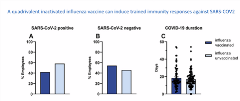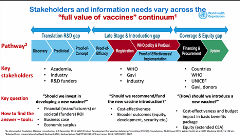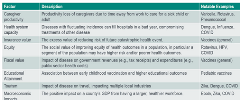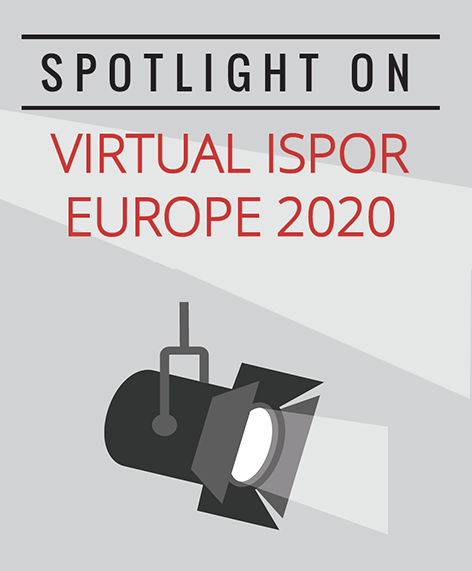How Can We Balance Quantifying the Broad Societal Benefits of Vaccines with Paying for Them?
Purva Parab, BPharm, MS, Virginia Commonwealth University, Richmond, VA, USA
Any pandemic that occurs usually has a very high impact on the economy and investments around the globe. Given the current pandemic situation, it is important to focus on the broad societal benefits of vaccines that are a solution to the pandemic. The session moderator, Daniel A. Ollendorf, PhD, Center for the Evaluation of Value and Risk in Health, Institute for Clinical Research and Health Policy Studies, Tufts Medical Center, Boston, MA, USA kicked off the session by raising the following questions for discussion: 1) Will better demonstration of broader economic benefits increase vaccine uptake? 2) What are the challenges in identifying vaccine-attributable benefits as the number of benefits captured increases? 3) What is the relationship between broad vaccine benefits, price, and threshold for determining “fair” value?
"Everyone, everywhere at every age fully benefits from vaccines for good health and well-being.”—Raymond Hutubessy, PhD
A Clinical Perspective
There are usually spillover benefits of vaccines where vaccination against one virus might affect outcomes of another virus. Panelist Carlo Giaquinto, MD, Department of Women's and Child's Health, University of Padova, Padova, Italy, gave his clinical perspective on the societal benefits by giving an example of the effects of the flu vaccine on COVID-19 and vice versa. A study conducted in Italy suggested that a higher influenza vaccination rate was associated with less COVID-19 deaths in adults. There was an indirect association between flu vaccination coverage and COVID-19 mortality rate. Influenza vaccination was also associated with lower COVID-19 incidence rates where those who were vaccinated had an approximate 50% lower risk of acquiring COVID-19 (Figure 1). Vaccinations can thus induce trained immunity response. Due to the increased benefits of flu vaccines on the current pandemic situation, there was also an observed effect of about 20-25% increase in flu vaccine coverage among healthcare workers. This is estimated to rise up to 60% in 2020-2021.An inverse effect was also seen where due to the precautions that people were taking to prevent COVID-19 (masks, sanitization, social distancing, etc.) there was decreased influenza activity.
Figure 1. Association between influenza vaccines and COVID-19 incidence rates.

Research and Policy Perspective
Raymond Hutubessy, PhD, Value of Vaccines, Modeling and Economics, World Health Organization (WHO), Geneva, Switzerland, as a team lead at WHO provided his perspective on certain immunization agendas that are in the works at the WHO. “Everyone, everywhere at every age fully benefits from vaccines for good health and well-being,” Hutubessy said.
The major implications of the immunization agenda for 2030 include equity uptake by everyone at every age and broader than health impact on well-being. Affordable new vaccine innovations are a top priority with focus on life course and integration of vaccines. The WHO new impact framework is moving from estimating direct risk benefit to impact and “full” value of new health interventions, said Hutubessy. The goal is to improve health and productivity not only at individual level, but also at a broader community level with benefits including the ecological effect, equity, financial, and programmatic synergies and sustainability and household security. Changes to household behavior, public sector budget impact, short-term, and long-term macroeconomic impact would also be considered, he said. In order to achieve this, gaps need to be identified across the full value of vaccines continuum. In Figure 2 Hutubessy identified the stakeholders and key questions to be answered by providing certain tools to do so.
Figure 2. Stakeholders and key questions Important for full vaccine continuum.

Industry Perspective
Craig S. Roberts, PharmD, MPA, MBA, Center for Observational and Real-World Evidence (CORE), Merck & Co., Inc., Kenilworth, NJ, USA, provided his industry perspective on the broader impact of vaccinations. There are a number of broader impacts that may be realized from effective implementation of immunization programs like summarized in Figure 3. However, the broader value of vaccines is often not included in economic analysis of immunization programs. Roberts said we need to include elements of broader value more often since vaccines are often cost-effective from a narrow payer perspective at public sector prices. The methods for estimating elements of broader value are not mature and would not be accepted by decision makers. With healthcare budgets being fixed, additional value for innovation would not result in more utilization of vaccines. Roberts then concluded by stating that there is a lot of value that we can gain from communicating with the financial side.
Figure 3. Broader impact of immunization programs.

The session concluded with all the panelists stressing the importance of community involvement in increasing the uptake of vaccination programs. Providing web-based information and more evidence would be important in educating people. Demonstrating a broader impact on economy and transparency on the value might also increase this uptake. Feeding the information on long term studies to public, scientists and decision-makers would also be key. Given the challenges with healthcare budgets, all the panelists (Figure 4) agreed that it would be important to keep value and expenditure separate and to realize that the long-term value of the vaccination programs would play an important role in balancing the budget. This value will differ in high- and low-income countries, irrespective more investment needs to be done in development of such programs.
Figure 4. Panelists (clockwise) Carlo Giaquinto, Raymond Hutubessy, Daniel A. Ollendorf, Craig S. Roberts.

Explore Related HEOR by Topic

